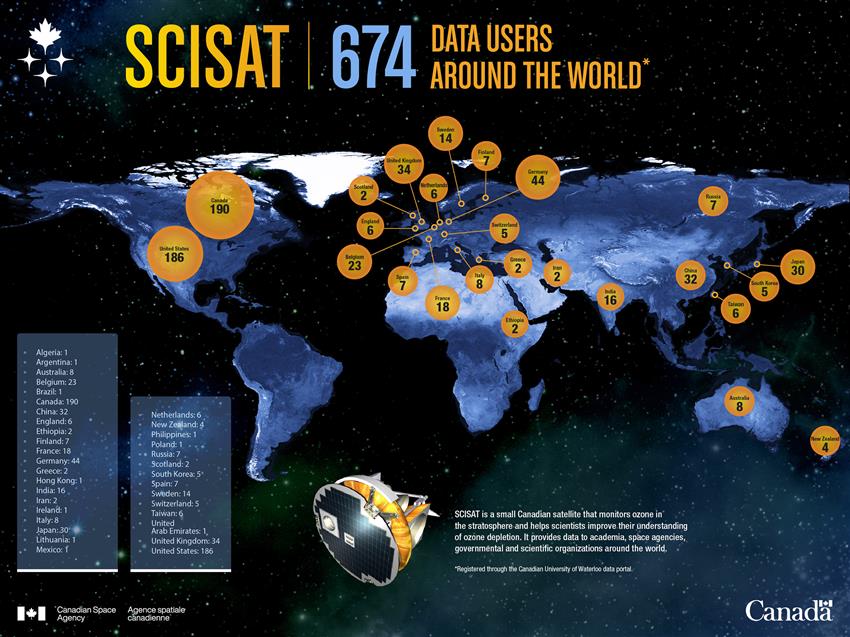About SCISAT

- Launch:
- Status:
- Active
Launched on , SCISAT helps a team of Canadian and international scientists improve their understanding of the depletion of the ozone layer, with a special emphasis on the changes occurring over Canada and in the Arctic.
The Canadian SCISAT mission is a partnership of universities, government, and industry. A scientific team of researchers from around the world, led by University of Waterloo chemistry professor Dr. Peter Bernath, is conducting the Atmospheric Chemistry Experiment (ACE) on SCISAT, which aims to measure and understand the chemical processes that control the distribution of ozone in Earth's atmosphere, particularly in the northern latitudes.
Originally intended to last two years, 20 years later the satellite is still operational and its mission has been extended until . "It's been a real success," said Dr. Bernath.
Tiny and thorough
SCISAT is the first atmospheric research satellite developed and flown by Canada since ISIS-2 in the early s. With a diameter of 112 cm, a height of 104 cm, and a total mass of only 150 kg, tiny SCISAT has a 650-km-high polar orbit, circling Earth 15 times a day. Its scientific instruments – ACE-FTS and MAESTRO (for Measurements of Aerosol Extinction in the Stratosphere and Troposphere Retrieved by Occultation) – identify the gases and particles in the atmosphere. The data helps us better understand ozone layer depletion.

Text version of infographics SCISAT in numbers
Infographic showing SCISAT in numbers. (Credit: CSA)
SCISAT focuses its attention in the stratosphere, where the ozone layer is located. Ozone protects us from the Sun's ultraviolet radiation and prevents most of it from reaching Earth's surface. Ozone – comprised of three atoms of oxygen – is constantly being created and destroyed by natural chemical processes in the atmosphere. The amount of ozone present at any given time varies depending on the balance between the processes of creation and destruction.
SCISAT provides the most accurate measurements to date of chemicals that affect ozone. It measures 70 different atmospheric trace gases, which is "more thorough than anything that's up there," said Dr. Bernath.
Ozone and chlorofluorocarbons
Industrial activities on Earth produce chemicals, notably chlorofluorocarbons (CFCs), that affect the balance between ozone creation and destruction. They not only reduce the ozone shield around the globe, but they also actually eat large holes in the ozone layer over the Antarctic each year, and cause significant losses over the Arctic. In the past two decades, average ozone levels over Canada have dropped about 6%, while severe declines of 20% to 40% have occurred over the Arctic in the spring.
SCISAT: an important asset for international environmental policy
SCISAT's high-inclination orbit takes it over the polar regions of Earth, as well as tropical and mid-latitude locations. Its data is making an important contribution to international environmental policy-making aimed at protecting the ozone layer, such as the Montreal Protocol that bans certain CFCs.
While the international community was making efforts to eliminate CFCs, new products were introduced to replace them: hydrofluorocarbons (HFCs), which are powerful greenhouse gases. To curb the growing concentration of HFCs in the atmosphere, the Kigali Amendment was made to the Montreal Protocol in order to limit HFC emissions. The scientists in charge of processing SCISAT data developed a method to determine the concentration of numerous HFCs, and they are continually improving their techniques in order to detect new ones.
SCISAT observations are also helping scientists better understand the effects of atmospheric chemistry, clouds and aerosols (small particles) on Earth's climate.
SCISAT measures the absorption of solar light by the atmosphere at sunrise and sunset. Different atmospheric constituents absorb different wavelengths of light in characteristic ways – a signature by which they can be identified. This technique is what allows SCISAT to make extremely accurate measurements.
The trade-off for this precision is that SCISAT takes measurements in a limited number of locations. Other satellites do provide more global coverage, but their data is not as accurate. "That's why there's great value in combining the two," said Dr. Bernath.
Moving beyond ozone depletion: Climate change and air pollution

Text version of infographics SCISAT: 329 data users around the world
Infographic showing the number of SCISAT data users in various countries. (Credit: CSA)
With its instruments performing so well, SCISAT has moved beyond its original mandate and is providing excellent data related not only to ozone depletion, but also to climate change, and air quality and pollution. "There are many things we're doing now that we really didn't know we could do," Dr. Bernath said.
SCISAT has been used to measure the distribution of several molecules correlated with air pollution and wildfires, providing data that complements the observations of the MOPITT instrument. "Together, they give you a picture of what's going on, and it's not a good picture. A lot of pollution that come from industrial activity travels all over the globe," Dr. Bernath noted.
Recent discoveries
SCISAT has continued to be very useful during recent phenomena that have disrupted the atmosphere. It was used to observe the injection of aerosols into the stratosphere by the – Australian bushfires. SCISAT data shed light on a new way in which ozone is being destroyed, involving aerosols and chlorine. This discovery helps explain the ozone depletion seen in the southern hemisphere after the fires.
The eruption of the Hunga Tonga volcano on , was so powerful that a large amount of material was injected into the stratosphere. SCISAT observations were used to estimate the quantity of water vapour injected into the stratosphere and to monitor the situation. Water vapour is the most powerful natural greenhouse gas and plays a key role in Earth's climate. The presence of water vapour at those altitudes, which are normally very dry, could alter the atmosphere's energy balance and lead to surface warming, and could also affect ozone chemistry.
